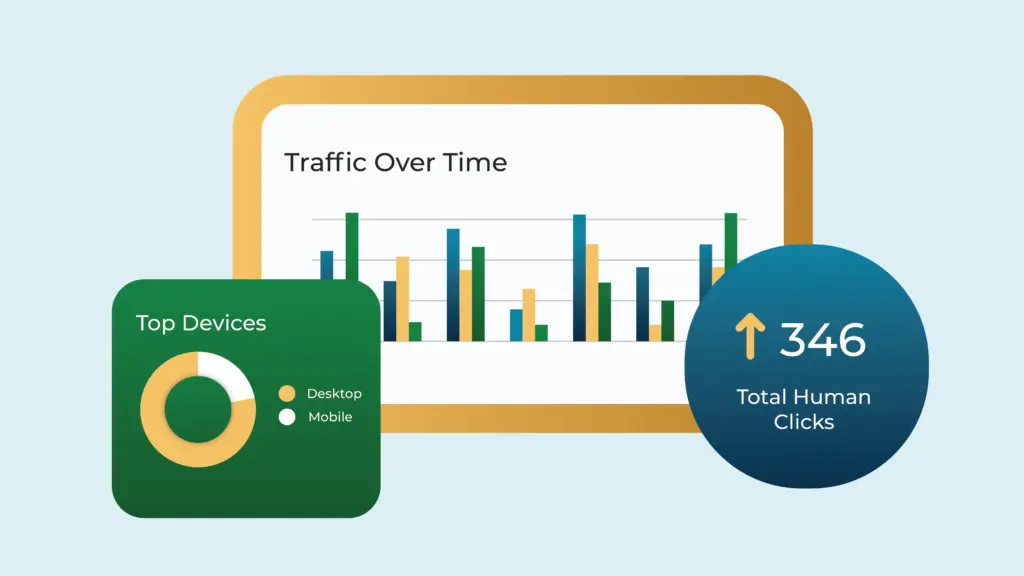What are URL shorteners? What are URL shorteners used for? Why would someone want to pay for a URL shortener when there are plenty of free plans? In this comprehensive guide, we dive deep into the history, uses, and value of URL shorteners.
URL shorteners have been around for a long time, but not many people understand how they work – or how to use them most effectively in their online business.
We’ll cover all there is to know in this comprehensive guide to URL shorteners. By the end of this post, you’ll understand how URL shorteners work on a technical level and the surprising benefits and use cases they can provide to the modern business owner.
Let’s get started!
Main Takeaways From This Article:
- URL shorteners trim lengthy, complex URLs into concise, memorable links, enhancing user-friendliness, aesthetics, and shareability on platforms like social media and email.
- URL shorteners help maintain cost efficiency, increase brand recognition, and improve click-through rates. They also enable tracking of engagement metrics and can include custom domains to boost brand visibility.
- URL shorteners work by taking a long URL, generating a unique identifier, and creating a short URL redirecting to the original URL.
- While generally safe, URL shorteners can help ill-intentioned individuals mask harmful links, thus requiring your cautious use.
- A free URL shortener like TinyURL is ideal for businesses seeking to optimize marketing efforts. It can support effective digital and offline marketing and help shorten URLs for sharing on marketing materials.
What Is a URL Shortener?
A URL shortener is a tool that compresses long web addresses—those lengthy strings of characters that can be cumbersome to handle—into shorter, more manageable versions. This not only makes the URL easier to share but also neater and more visually appealing when included in text messages, social media posts, or even print materials like business cards and flyers.
Essentially, a URL shortener acts as a middleman between your long URL and a much shorter one that is easier to work with. When you use a URL shortener, it generates a brief alias or shortcut that still directs users to your intended destination, just like the original URL would.
Using a URL shortener is not just about making links shorter; it’s about making your communication more effective, your brand clearer, and your campaigns more trackable. We’ll discuss all those at length, so stick around!
How URL Shorteners Work
To understand how URL shorteners work, we need to go through a quick primer on how URLs work.
URL Basics
A URL, or Uniform Resource Locator, is essentially the address of a specific resource on the internet, similar to how a physical address points to a specific location. Here’s a simple breakdown of its components:
- Protocol: This part of the URL tells your browser how to communicate with a website. Examples include HTTP and HTTPS, where the ‘S’ stands for secure.
- Domain Name: This is the name of the website you want to visit, like ‘google.com.’ It’s a human-friendly way to access the vast and complex internet without needing to remember complicated numbers.
- Path: The path directs your browser to a specific part of the website. For example, in ‘example.com/blog,’ the path ‘/blog’ leads directly to the blog section.

How URLs Facilitate Internet Navigation
When you type a URL into your web browser, it follows these steps to bring you to the webpage:
- Find the Address: The browser uses the domain name (like ‘google.com’) to find the correct server. It’s like looking up a phone number in a phone book.
- Make the Request: Using the protocol, your browser sends a request to the server that hosts the website, asking for the page you want to see.
- Follow the Path: Once connected to the server, the browser follows the path provided in the URL to locate the exact information or page you requested.
This process allows your browser to retrieve and display the website you want to visit quickly and efficiently. By understanding these basic components, you can navigate the internet more effectively and make better use of its vast resources.
URL Shortening Process
Building on our understanding of traditional URLs, shorteners simplify this process by creating more manageable links that still direct users to the desired web page. Here’s how the URL shortening process and redirection operate:
- Input the Long URL: You start by entering the lengthy URL that needs shortening into the URL shortener tool. This could be a long link to an article, a signup page, or any other online resource.
- Generate a Shortened Link: The URL shortener then creates a much shorter, unique version of the URL. This typically involves generating a random or custom string of characters that serves as the new identifier for your long URL.
- Store the Link Pair: The original long URL and its new shortened version are paired and stored in the shortener’s database. This database keeps track of all the shortened links and their corresponding original URLs.
Redirection Process
- Click on Shortened URL: When someone clicks on the shortened URL, their request is sent to the server hosting the shortener service.
- Lookup Original URL: The server quickly searches its database for the short link to find the associated original URL.
- Redirect to Original URL: The server then redirects the user’s browser from the short URL to the long URL, seamlessly taking them to the resource they intended to access.
The process of shortening links is quick and straightforward, ensuring users can easily reach their intended online destinations. In the following section, we will delve into the extensive benefits that URL shorteners offer. Understanding these advantages will equip you to utilize URL shorteners more strategically within your digital initiatives, ultimately boosting both the efficiency of your communications and the impact of your marketing efforts.

Benefits of Using a URL Shortener
While custom URL shorteners can make your links prettier, they also provide many more surprising benefits. Here’s how a URL shortener can be a game-changer:
Ease of Sharing: Shortened URLs take up less space, making them perfect for platforms like Twitter, where every character counts. They’re also simpler to include in emails, on business cards, or in promotional materials without cluttering the design or overwhelming the reader.
Saving Space Where Character Limits Matter: Space is a precious commodity on services like X (formerly Twitter), where there’s a strict 280-character limit, or SMS, where there’s a 160-character limit. Every character counts, and long URLs will eat up your limit quickly. In these situations, a URL shortener can make your life much easier. For example, if your URL is 100 characters long, a URL shortener might shrink it to just 20 characters. That leaves you with 80 extra characters to get your message across in a more detailed fashion.
Boosting Trust and Click-through Rates: Malware and scams are everywhere, and most people are understandably wary of clicking on links they don’t recognize. Short links are tidy and more enticing to click, especially when they include words related to your brand or the content they lead to. This clarity can significantly increase the chances of people trusting and engaging with your links.
Simplified Updates: If you need to change the destination of a link after it’s been distributed, a URL shortener makes it easy. Instead of replacing the old URL in every location it’s been shared, you can update it centrally through the link shortener’s dashboard, saving you time and ensuring consistency.
Building Brand Recognition: URL shorteners can also be a powerful branding tool. They allow businesses to create branded links that reflect their identity and message. Businesses can increase their brand awareness, engagement, and conversions by using custom domains that are relevant and meaningful to their brand. Here are some examples of businesses that use custom URL shorteners to improve their brand recognition:
- Amazon: amzn.to
- New York Times: nyti.ms
- Buzzfeed: bzfd.it
- LinkedIn: lnkd.in
- Facebook: fb.me
- Microsoft: aka.ms
Tracking User Engagement: When you use a URL shortener, you gain access to valuable data. You can see how many people clicked your link, where they did it, and what device they used. You likely already use an analytics tool, but the tracking and analytics capabilities of a premium URL shortening service can shore up weaknesses in tools like Google Analytics, where you can’t differentiate between different sources of direct traffic. This information is crucial for understanding what excites your audience and optimizing your future content.
We’ll discuss the tracking and analytics capabilities in more detail later in the post, so keep reading to learn how link shorteners can upgrade your marketing capabilities.

Common Use Cases for URL Shorteners
URL shorteners are not just a useful tool for simplifying web addresses; they’re powerful assets that can significantly boost marketing and communication strategies. In this section, we’ll explore practical use cases of URL shorteners, highlighting how they can be leveraged to enhance efficiency and insight across various platforms and mediums.
SMS Marketing
SMS marketing is a powerful tool in the modern digital landscape.
With an impressive average open rate of 98% per SlickText, it far outstrips email, which hovers around 21%, according to Campaign Monitor.
However, the 160-character limit per message in SMS marketing can make it challenging to include long URLs while maintaining cost efficiency.
Link shorteners are a powerful tool in the SMS marketer’s toolkit, as they help save valuable message space, fit more content, and calculate click-through rates (CTR) for their campaigns.
Email Marketing
With an average ROI of $36 for every dollar spent, email marketing is a golden opportunity for marketers. But, like any digital strategy, it has its challenges – especially when it comes to links.
- Spam filters can block or flag emails containing suspicious or malicious links.
- Long, cluttered URLs can also detract from the quality of your content and take up valuable screen space.
- Some email marketing tools have notoriously basic link-tracking capabilities.
Link shorteners help you avoid these issues by providing short, clean, and branded URLs that effectively track direct traffic without the need for unsightly UTM tags.
Offline Marketing
Offline marketing’s impact can be tricky to gauge, but combining link shorteners with QR codes can effectively measure its success. For example, imagine placing QR codes on three different posters, each linking to your homepage. Without differentiation, tracking the traffic source is impossible.
However, by using unique shortened URLs for each poster’s QR code, you can pinpoint which attracts more visitors. URL shortener services like TinyURL offer analytics dashboards that detail traffic patterns by time, day, and location, providing valuable insights for future campaigns. Additionally, custom-branded domains for these links can improve recall and ease of entry, further enhancing your offline marketing efforts.
Alternative to UTM Tags
UTM tags are indispensable for tracking the effectiveness of digital marketing campaigns, but they typically make URLs lengthy and complicated. URL shorteners can encapsulate these tags within a shortened link, preserving the tracking capabilities while making the URL more user-friendly. This approach is especially useful in social media posts or other platforms where a shorter link is more likely to be clicked.
Additionally, it keeps the link’s aesthetic clean and professional, which can enhance brand perception and trust among users. For example, a business using social media to drive traffic to its website can use a shortened URL that includes UTM parameters to monitor which platforms are generating the most clicks and conversions.
Why Would Someone Want To Pay for a URL Shortener?
Paying for a URL shortener service offers several advantages that free plans may not provide, making it a worthwhile investment for businesses focused on brand building and detailed analytics. Here are some key reasons why someone might choose to pay for a URL shortener:

- Customization: Paid URL shorteners typically allow users to create custom short links incorporating their brand name or specific keywords. This not only reinforces brand recognition but also increases trust among users who see a recognizable and relevant name in the link.
- Advanced Analytics: While free services provide basic click data, paid plans often offer more detailed analytics. These include demographics, click behavior, conversion tracking, and integration with other marketing tools like Google Analytics. Such detailed insights are crucial for optimizing marketing strategies and understanding audience behavior.
- Increased Number of Links and Tracking: Paid plans usually allow for the creation of more links and offer longer data retention for tracking each link’s performance over time. This is essential for long-term campaigns and comprehensive reporting.
- Enhanced Security Features: Paid URL shorteners can offer additional security measures to protect links from spam and fraud. This may include more robust redirection options, the ability to change the destination URL after it’s been shared, and custom redirect pages that can enhance user trust.
- API Access and Integration: For businesses that need to automate their processes, paid URL shorteners often provide API access, allowing them to integrate link creation and tracking directly into their systems and workflows. This integration can significantly streamline operations and increase efficiency.
- No Ads: Free URL shorteners might generate revenue by showing ads to users who click on a shortened link. Paid plans generally do not have ads, providing a cleaner and more professional user experience.
Investing in a paid URL shortener service can significantly enhance a company’s digital marketing capabilities, offering greater control, comprehensive analytics, and better branding opportunities, all of which contribute to more effective online communication and promotional activities.
Choosing the Best URL Shortener
Selecting the appropriate URL shortener is crucial for enhancing your digital strategies effectively. Here are several considerations to help guide your decision:
- Feature Set: Determine which features are most important for your needs. If you’re focused on marketing, look for a shortener with robust tracking and analytics to monitor campaign performance. If brand visibility is a priority, choose a service that offers custom branding options for your shortened links.
- Reliability and Uptime: Your URL shortener should be reliable with minimal downtime, as interruptions can lead to broken links and missed opportunities. Research the provider’s performance history or look for reviews to gauge reliability.
- User Experience: Consider the interface and usability of the shortener. It should be intuitive and straightforward, allowing you and your team to create, manage, and analyze links without extensive training. A good user experience will save time and reduce frustration.
- Support and Resources: Good customer support can be invaluable, especially when you encounter issues or have questions about advanced features. Additionally, check whether the provider offers resources like tutorials, forums, or detailed documentation to help you maximize their service.
- Pricing Structure: Examine the pricing plans carefully. Does the provider offer a free account to test services before committing? Are there different tiers depending on the volume of links and the level of analytics you need? Make sure the pricing aligns with your budget and the ROI that the tool can deliver.
How Does TinyURL Work?

Creating a short URL with TinyURL is as easy as 1-2-3! Here’s how:
- Head Over to TinyURL: Open your web browser and visit https://tinyurl.com/app.
- Paste and Shorten: Paste the long URL you want to shorten in the “Enter long link here” box. Once pasted, click the “Shorten URL” button.
- Your Short URL is Ready! TinyURL will instantly generate a shortened version of your link. The short URL will be displayed on the screen.
That’s all there is to it! TinyURL keeps things straightforward, allowing you to shorten links in seconds without any complicated steps. Now, you can copy and paste the shortened URL wherever you need it, like social media posts, emails, or text messages.
Pro tip: You can customize your link for free by providing an alias in the “Enter alias” box. This will customize the path that comes after “tinyurl.com”. For example, “tinyurl.com/yourbrand”. You can also upgrade to TinyURL’s paid plans to customize your shortened links with a branded domain!
How to Know if a URL Shortener Is Right for You
Not sure if a URL shortener is right for your business? Ask yourself these questions and consider whether you could use help in any of these areas:
- Do You Want to Drive Traffic to Key Destinations? Driving traffic to key online destinations is critical to any business strategy. These destinations could range from your company’s main website to a specific blog post, a scheduling form, a social media page, or any other digital platform where you want your audience to engage. So, if your answer was a ‘Yes,’ then a URL shortener can be a game-changer for your business.
- Do You Care About the Results Your Links Are Getting? If you’re investing time and resources into creating content, it’s only natural that you want to know the effectiveness of your efforts. This is where the analytics provided by URL shorteners come into play. URL shorteners can provide you with valuable data about your links by tracking key metrics like who accessed the links, what time of the day, and using which device. So, to stay on top of your website performance and content marketing campaigns, using a robust URL shortener like TinyURL is non-negotiable.

- Do You Want to Avoid the Problem of Sending the Wrong Links? Sending the wrong or broken links can be detrimental to your business. It can lead to a poor user experience, lost sales, and a damaged reputation. URL shorteners can help you avoid these issues by easily editing your links without changing their appearance or breaking them. This is another reason you should definitely start using a reliable URL shortener.
- Are You Concerned About Building Trust and Brand Recall? Trust and brand recall are crucial for any business. When your audience recognizes and trusts your brand, they’re more likely to engage with your content and convert into customers. URL shorteners can help you build trust and improve brand recall by allowing you to create branded links. So, if your links aren’t branded yet, recreate them using a URL shortener.
- Are You Rethinking the Look and Feel of Your Website’s Domain Name? Your website’s domain name is often the first point of contact between your brand and potential customers. It must be memorable, meaningful, and appealing. So, if it isn’t short and crisp and may even be heavy on the eyes, you should optimize its appearance using a URL shortener. URL shorteners let you hit ‘reset’ on domains you’ve already selected.
- Do You Want to Take a More Organized Approach to Link Management? As your business grows and your digital presence expands, managing your links can become daunting. If you answered “Yes,” a premium link shortener can help you better manage your links.
Maximize Impact With Every Shortened Link Using TinyURL
Whether you want to drive traffic, track results, avoid incorrect links, build brand recall, rethink your domain name, or better organize your links, a premium link-shortening service like TinyURL can be a powerful tool in your digital marketing arsenal.

As the oldest name in the link-shortening game, TinyURL pioneered the custom URL shortener in 2002 and broke ground in providing free and premium link-shortening options for everyday users and enterprise customers.
Our platform is reliable and secure. It offers simple tools for managing your short URLs and an analytics dashboard that can drill down to the metrics of individual links or give you the big-picture performance of entire campaigns.
With a premium service like TinyURL, you can:
- Tag shortened links for easier organization
- Filter by tag or alias to easily find the links you need
- View analytics during a certain period
- View top referral sources and languages
- View top browsers, operating systems, and devices
These data points can help you keep track of your links and understand which ones are performing well and which ones need improvement.
Sign up for a free TinyURL plan to get started!



